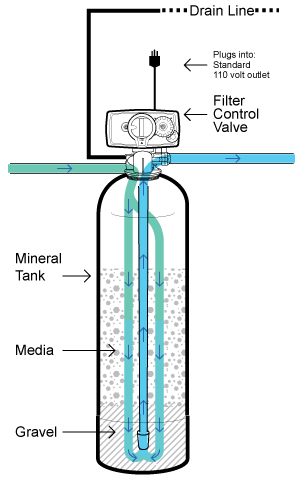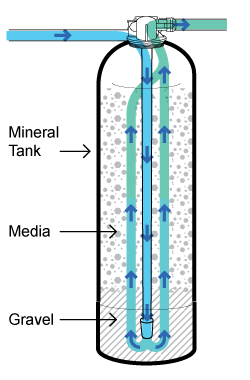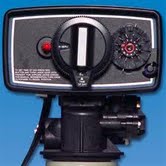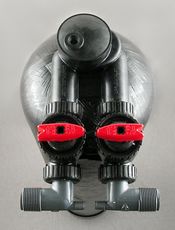Special Mid-Month Issue October 15, 2011 Read This Issue on The Pure Water Occasional Website |
|---|
Tank-Style Whole House Filters for City Water
"Whole house" water filters for city water users can be either cartridge-style or tank-style. Cartridge filters are in general more compact and relatively easy to maintain. They are also a bit easier to install. Tank-style filters are larger and offer longer service runs between media changes. Tank-style filters are also less restrictive of water flow.
The main purpose of whole house filters for city water users is the removal of the disinfectants chlorine or chloramine added by the city. This means that carbon in some form is almost always the medium of choice. Carbon is sometimes combined with KDF for enhanced performance, but carbon is virtually always the workhorse. (This article is about filters. Water softeners, which are similar in appearance to tank-style filters, are not filters and are not being considered here.)
Removing disinfectants fixes most taste/odor issues and almost always improves water aesthetically. Disinfectant-free water is much more pleasant for bathing and general household use. Chlorine-free shower water is definitely a health advantage, as evidence grows of chlorine's bad effects on the skin and the body in general. Breathing chlorine given off in shower water is clearly a negative to health. Some people are more sensitive to chlorine and chloramine than others, and to them using a good dechlorinating or dechlromaminating filter can be a life-changing advantage. Added advantages to having a whole house carbon filter include the removal of the by-products of disinfection (THMs) and other extraneous chemicals that might be in the water and protection of water softeners (softeners are always installed after the whole house filter, which protects their resin from degradation). Disinfectant-free water is preferred for almost any household function.
 |
|---|
| All whole house backwashing filters work like the one above. Water to be filtered enters from the left, passes down through the media bed, enters the bottom of the center tube and is returned to the control valve, which sends it out at the right for service in the home. The bed is "renewed" at pre-selected intervals by "backwashing." In backwash mode, the control valve sends incoming water down the center tube at high volume. Water entering the tank at the bottom lifts and cleanses
the media bed, washing impurities out through the drain line. A final rinse (top to bottom) cleans the bed and resettles it for return to service. There is a more detailed explanation of this in our "How It Works" section. The gravel underbed, by the way, is not necessary on many modern filters that are made in "Vortech" mineral tanks. |
FAQ, Featuring Pure Water Annie
 |
Technical consultant Pure Water Annie answers the most frequently asked questions we get by phone and email about whole house tank-style filters for city water users. |
|---|---|
Will this filter give me great drinking water at every tap in my home?
No. A whole house filter isn't a substitute for a drinking water filter. Drinking water units get to handle the water much more slowly and in limited quantity, so they can be made much tighter and therefore more effective. It's also easy to add extra media to treat lead, arsenic, fluoride, etc. in small drinking water units. This is not practical for a whole house city water filter, which is mainly a disinfectant remover. This is not to say, however, that with a whole house filter you won't be able to get a glass of tasty, much improved water from any tap in your home.
Do your whole house filters remove fluoride?
No. Filter carbon can remove some fluoride under the right conditions, but this isn't a reliable or easily predictable property of carbon. Fluoride can be removed handily from drinking water by reverse osmosis or by specialty filter media like activated alumina.
A few websites sell whole house fluoride filters. Why don't you?
Mainly because we don't believe that they can be made to work as advertised. For fluoride removal with the standard fluoride media, the rate of flow would need to be very slow and the filter or filters gigantic. With current technology, whole house fluoride reduction isn't practical. The best way at present to get fluoride out of your bath water is to bitch persistently at your city government for adding it to the water. Most of the enlightened world has rejected public water fluoridation, and an increasing number of cities are dropping fluoridation as a bad idea.
How can I be sure the filter is removing all the chlorine or chloramine from my water?
Actually, you can be sure that it isn't removing all the disinfectants or all of anything else. Water treatment is always about reduction, not complete removal. Not even the best steam distiller removes all of anything. When an advertiser promises that his filter removes 99% or 97% of the chlorine or chloramine, he's counting on the fact that you have no way to test his claim. (To test this with any degree of accuracy, the filter would have to be installed in a qualified testing laboratory) He is also relying on the fact that big filters are so cumbersome that returning one that's had water in it is essentially impossible.
Disinfectant reduction depends on so many variables that accurate prediction of results is not feasible. You have to consider rate of flow (the most important of all, and one of the few variables you have some control over), water temperature, mineral content, turbidity, and pH of the water, amount of chlorine/chloramine, length of service flow cycles, et al.
The most practical way to measure disinfectant reduction is with simple tests available from pool and pet stores. We think it's fair to assume that you'll get a 90% plus reduction from a whole house filter that's operated with the recommended flow limit--and certainly that enough disinfectant will be removed that you won't be aware of its presence.
How long will the carbon last before I have to change it?
The many variables--flow rate, amount of disinfectant, other factors in the water, the number of gallons of water used--make it impossible to give a precise answer, but in normal residential filters a three or four year service life of the carbon is a reasonable expectation. It can be much longer if conditions are right.
Is changing the carbon a hard job?
In general, it isn't a hard job, but it can be a messy job. It depends on where the filter is installed. If it's accessible, it's a matter of screwing the top off of the filter, like screwing the lid off of a bottle, pouring out the contents, and pouring in new carbon. The carbon is the consistency of coffee grounds, but there's a lot of it, and when it's wet, it's heavy.
 |
|---|
| The tank-style filter above is a non-backwashing style that is often called an "In/Out" filter. It can be installed either as an upflow filter (like the one above) or a downflow filter. Service flow is bottom to top, as shown in the illustration, Since it doesn't have to backwash, you can put more carbon in the tank. |
Are backwashing filters better than In/Out style filters?
Each style has its advantages and disadvantages.
In/Out units are less expensive to purchase, hold more filter carbon per tank size, require no electricity or drain hookup (making them easier to install), and require no control-valve maintenance.
On the negative side, since they have no way to get rid of trapped particles, In/Out units can be used only on clean water and even so must have a sediment filter installed in front of them to protect against unexpected events like water pipe repairs. Rebedding the filter costs more because more carbon is required.
Backwashing filters can be used to treat dirtier water and the pre-sediment filter is optional, since they can backwash out collected impurities. They have the ability to renew their filter bed to prevent "channeling," and their performance is more predictable.
Negatives for backwashing filters are higher initial cost, the need for electricity, and the need for access to a drain. Backwashing uses water (50 gallons plus per backwash, depending on the size of the filter) and if done frequently can actually shorten the life of the carbon by physical breakdown. Although backwashing filters are very reliable, they are more complex than In/Out filters and are consequently more likely to need maintenance.
 |
 |
|---|---|
| Fleck 5600 Filter Valve. A tough, simple head for small backwashing filters. | Clack In/Out Head with bypass installed. No electricity or drain needed. |
How about KDF? Do you put it into your carbon filter tanks?
KDF is good stuff in its place--in shower filters, for example. Under the right conditions, It can prolong the life of carbon and keep it clean. In general, though, we do not like mixed bed filters because one of the media usually outlasts the other and requires a different backwash regimen. We can provide a small KDF tank to pretreat for your carbon tank (though we feel this is unnecessary), but we don't like putting the two media in the same tank.
How about chloramines? What kind of filter is best for chloramines?
One of the big myths about chloramine is that it can’t be removed. Actually, it is removed with filter carbon, the same filtering agent that very effectively removes chlorine. The difference is that chloramine is much harder to remove. Therefore, it takes more carbon, and water must be given more residence time in the carbon. In other words, you need a larger carbon bed and a significantly slower flow rate to remove chloramine with standard carbon.
A specially prepared carbon, called catalytic carbon and referred to sometimes by the name of the most popular brand, Centaur, is much better at chloramine removal than standard carbons. Catalytic carbon filters can be sized smaller than standard carbon models when used for chloramine reduction.
How large a filter do I need?
This is the hardest question to answer. In general, it's probably impractical to size a residential filter so that its service flow limit is never exceeded. If a treatment professional were planning a system to treat well water known to be contaminated with a dangerous chemical, adequate sizing would be essential. With a residential disinifectant reduction filter, the consequences for going over the limit now and then are a slight reduction in water quality and shortening of the lifespan of the carbon bed.
Filters of this type are sized by gallon per minute (gpm) flow rates. A carbon bed requires certain residence time with the water (the engineering term is EBCT, for "empty bed contact time"). The larger the bed, measured in cubic feet of carbon in the tank, the faster the permissible flow rate. The contact time required for chloramine reduction is much higher than for chlorine reduction.
Every home is different, but there are charts that will allow you to make a guess at average gpm requirements. Here's a chart I made for a previous article.
| Number of Residents | 1-2 Bathrooms | 2-3 Bathrooms | 3-4 Bathrooms | 4-5 Bathrooms |
| 1-2 | 5 GPM | 7 GPM | 10 GPM | 12 GPM |
| 2-4 | 7 GPM | 10 GPM | 12 GPM | 14 GPM |
| 5-6 | 10 GPM | 12 GPM | 14 GPM | 18 GPM |
| 7-8 | 10 GPM | 12 GPM | 14 GPM | 18 GPM |
| 9-10 | 12 GPM | 14 GPM | 18 GPM | 20 GPM |
Here's another chart of suggested "maximum" flow rates. Keep in mind, again, that you won't be arrested or fined if you exceed the suggested limit now and then. The penalty for going over the limit is reduced performance and carbon life.
| Media Bed. Amount of Carbon in Cubic Feet. | Coconut Shell Carbon, For Chlorine Reduction. Maximum GPM Limit | Centaur Catalytic Carbon, For Chloramine Reduction. Maximum GPM Limit |
|---|---|---|
1 |
4 |
2.5 |
1.5 |
5 |
3.75 |
2.0 |
7 |
5.0 |
2.5 |
8 |
6.25 |
3.0 |
10 |
7.5 |
The most popular tank size for city water tank style filters is the 10" X 54". It holds 1.5 cubic feet when used as a backwashing filter and about 2.0 cubic feet as an In/Out unit. A glance at the average gpm chart indicates that most filters of this type are undersized. Undersized or not, they are very popular items and people love the water they produce.
More Information about Tank Style City Water Filters
Pure Water Products 5600 Backwashing Filters. The most basic carbon and Centaur carbon filters with Fleck 5600 control. (These filters are made with Vortech tanks.)
Fleck Basic Backwashing Filters. Lets you choose the size and filter media for Fleck control filters up to 10 cubic feet in size.
The Chloramine Catcher. Pure Water Products' sturdy chloramine filters built with Vortech tank, the 2510 control, and Centaur catalytic carbon.
Pure Water Products Tank-Style Upflow Carbon Filters. Both coconut shell and Centaur non-backwashing upflow filters featuring Clack In/Out head and Vortech tanks.
How Backwashing Filters Work. From the Occasional's How It Works Series.
How In/Out Filters Work. From the Occasional's How It Works Series.
The Pure Water Occasional is a project of Pure Water Products. Please visit our websites: Main Website; www.purewaterproducts.com This site features our full range of products, plus instructions, technical articles, product manuals, and more. The Occasional's Website: www.purewateroccasional.net. In addition to archiving back issues of the email Occasional, this site houses a sizeable section about water contaminants, a "how things work," series, a new products section, a glossary of water treatment terms, and, "much, much more." Other Pure Water Products Sites: www.purauv.com
|
|---|
